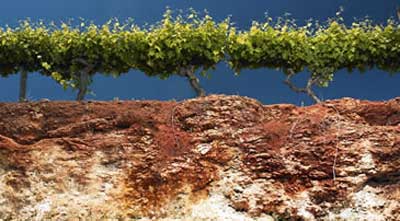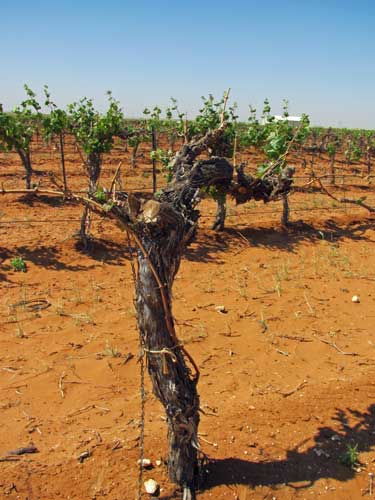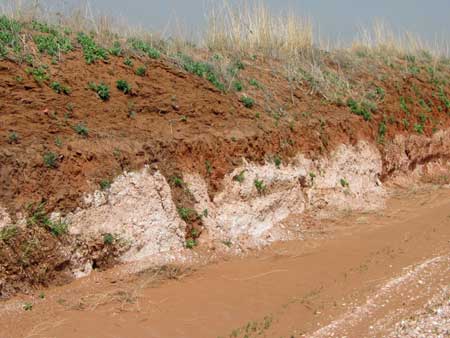Texas High Plains Vineyard Visit: A Relapse of “Coonawarra Envy”
Those who have read my blog over its nearly three years of existence have read my periodic rants on the red sandy loam of the Texas high plains and their likeness to the terra rosa of the Coonawarra wine growing region of Australia. Some have called it a bad case of “Coonawarra Envy“. The reason that I’ve proceeded along this line of thought (again, as before) is that the criteria for identifying wine regions in many parts of the world and the delineation of their boundaries generally follow a linkage to geology and soils. In Australia, the premium wines of the Coonawarra, particularly Cabernet Sauvignon, are equated with precisely the terra rossa soils that define this region.
Terra rossa is red-brown topsoil laid over porous limestone. It’s the oldest and most fertile soil on the adjoining limestone Coast. The origin of the limestone is traced back to ancient submarine deposits, when the ocean extended inland. As the land rose above sea level this limestone became the principal substrate for the terra rossa, but is not linked to their origin. Wind deposited organic matter and oxidized iron-rich soil yielded the rich rusty-red color of the surface soils of and consequently its name: terra rosa. This soil stata provides excellent surface drainage for grape cultivation with water retention in the porous underlying limestone where the deep roots of grapevines reside.
A this year’s Newsom Vineyards Grape Field Day (and event that’s been happening for about 25 years on Neal Newsom’s Texas high plains vineyard property), I found one more reason to like the Aussie terra rossa or what Texans could call their own high plains “tierra roja”. It came on me like a Mack truck on a narrow Texas road. It was during Dr. Ed Hellman’s presentation. He said that red soils are associated with fruitful grapevines for one very good reason: because they are red! It all has to do with photons of sunlight that reflect from the ground around the vines. It appears that red light stimulates the buds more than other wavelengths of light and, in turn, helps the vines produce more and better grapes.
As my van returned to Lubbock following the afternoon session at this year’s Newsom Field Day, the wind was over 30 mph blowing clouds of red sandy dust into the sky in front of us. On the way to the meeting, I saw a road cut that interested me. On our return trip was watching for it and I wanted the opportunity to inspect it closer. The only concern I had was could I find it in the midst of red blowing sand.
Finally, on the left ahead of us, the cut came into view just like the one that I’d seen in several wine books and on Internet websites that pined on and on about the terroir of the Aussie Coonawarra. Red sandy loam over porous caliche limestone. By some reports the topsoil varies from as little as a couple feet think up to maybe six to ten feet deep. Just like the Coonawarra’s red soil, this tierra roja was was not formed in place, but the result of erosion and wide transport from the slopes of the Rocky Mountains farther to the west and north. Under the topsoil, the limestone extends in many places up to thirty feet. I’ve been told that when excavations taken place in the vineyards, the roots of the grapevine are found extending well into the limestone substrata.
The Aussies may call me crazy for my fixation on their patch of red dirt (click here). But, to me it tells a story. It’s a story of why it’s not so crazy to expect good wine grapes to be grown on the Texas high plains. Good red soil is an important part of Texas terroir. There are other factors too that combine with the red dirt. One important aspect is the cooling influence of 3500 feet of elevation and near bone dry conditions that yields a large diurnal temperature swing: warm by day, cool by night.
I just can’t seem to get enough of this red dirt. After our outing, I returned to my hotel room to find out that some of it seems to like me too. It was in my ears, eyes and nose. Some of the sandy red particles even found there way into my Blackberry Torch smartphone. It still reminds me of the trip. Even today, two weeks later, it produces a scratchy sound whenever I flip out the keypad.





I cannot wait for your book to hit the shelves.
Terroir!
Don
The target release date from Texas Tech University Press is March 1, 2012….and counting!
The grapes used for this type of wine are also unique. They are round, small, very dark with a very rough skin. The roughness of their skin actually protects them from being damaged especially when the autumn rains start to pour in. This also prevents them from being contaminated. These are the very qualities of the Cabernet Sauvignon grapes that makes them one of a kind hence, the wine they produce are one of a kind too.
I think that this year, Texas grapes are just little sacks of seeds, great for taking camping. They are light and you just have to add water to make some mighty fine wine.